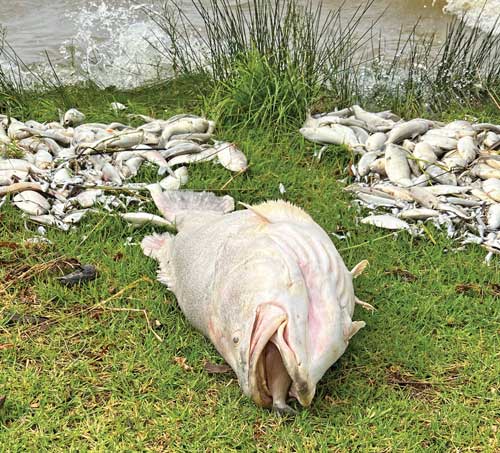For decades, the small town of Menindee was little known to the rest of Australia.
A country town located in the far west of NSW, it was known for being the ‘trading hub of the west’ during the 1800s.
Yet in recent years, the township has made international headlines due to the alarming occurrence of fish kills.
For weeks, it was the hot topic for news stations that showcased the millions of dead fish floating in the river.
First Nations people and other locals who bathe, drink, fish and recreate in those waterways were angry.
They raised concerns for the health of the region and sought answers.
Following a recent government inquiry into the events, Professor Lee Baumgardner – a freshwater fish scientist who led the scientific review in the investigation – joined OzCast to explain why these events were occurring.

The special value of this explanation stems from the fact that many fish kills in Australia are not natural events, unlike in Europe or the Americas.
Species such as Atlantic salmon will swim upstream to spawn, die and then float back down the river.
However, in our plus 65,000-year history, there is nothing to suggest that Australian species have this life-history strategy.
All the fish kills we have seen in the Murray-Darling Basin were due entirely to humans altering the river.
Which is why answers were being sought.
The causes of fish kills are often complicated.
Understanding them requires dissection of the timing of the event, the river’s flow, weather conditions, nutrient, bacteria and algal loads, and river infrastructure.
Interestingly, both the 2018 and 2023 events had different catalysts.
As Prof Baumgardner explains, both fish kills were due to a lack of oxygen.
Yet how we came to that was due to different preceding weather events, or ‘perfect storms’.
What happened in 2018?
In the 2018-19 period, the Baaka (Darling) River and many other inland rivers faced a dire situation marked by extreme low flow.
The Baaka (Darling) River came to a standstill, with a limited trickling flow.
This created what could be described as a perfect storm.
High nutrient levels in the river spurred a blue-green algal bloom during the summer, progressively growing in magnitude.
The sun acted as a catalyst, superheating the top layer due to the absence of wind and flow.
In the weeks preceding the event, Menindee had multiple 40C plus days.

Blue-green algae are microscopic organisms that, under favourable conditions, can produce toxins – cyanotoxins – harmful to fish and other life forms.
Their rapid growth can deplete oxygen levels in water, affecting fish survival.
The focal point of this crisis was the Weir 32 weir pool.
An excessively warm top layer saturated with algae hosted the majority of the fish.
Beneath this layer, an oxygen-deprived zone formed, leading to a stratified – or layered – environment in the water.
During the day, algae in the warm layer produced oxygen, while at night, both fish and algae consumed it, resulting in a notable oxygen loss in this top layer – the only layer supporting the fish.
In a critical turn of events, three cool weather changes swept through, causing the weir pool to flip.
This led to the mixing of the bottom layer with zero oxygen and the poor oxygen top-layer, resulting in a sudden fish kill as low oxygen reached the fish, causing them to suffocate instantly.
Subsequent cool changes perpetuated a positive feedback loop, with dead fish sinking to the bottom, creating conditions for further fatalities.
The cascading effect reached a climax during the next cool change, causing a systemic collapse of all life in the river upstream of Weir 32.
What happened in 2023?
In 2023, as floodwaters surged through the northern basin, run-off inundated floodplains, carrying with it an excessive amount of organic matter.
Years of low flow preceding 2023 led to an accumulation of sticks and leaves on the floodplains.
When washed into the water, this organic matter began breaking down, consuming a significant amount of oxygen – more than the river could withstand.
The aftermath of this blackwater event was a detrimental sludge of water making its way downstream towards Menindee and Weir 32.
Weeks before the crisis unfolded, the gates on Menindee Main Weir were closed with flow being directed into Menindee Lakes.
Flow into the Weir 32 weir pool was now significantly reduced to stagnant conditions, with high nutrient levels and algae blooms, a situation reminiscent of 2018.
As more pockets of deoxygenated water also forced fish upstream, an astonishing congregation occurred between Weir 32 and Menindee Main Weir.
About 30 million fish were estimated to have crammed into this weir pool.
The sheer magnitude of the fish population gathered in the affected area became evident when the situation turned dire.
The consequences were not confined to a few fish – it affected millions.
This was exacerbated by the fact that there was no fish ladder at Menindee Main Weir to allow the fish to move away from the area.
The swiftness with which the bad water inundated the area added to the complexity of the situation, catching everyone off guard, including the fish.
This was worsened by the immense concentration of fish in that stretch of the river.
It would be similar to sticking 10,000 people in a small room and shutting off all the exits.
Eventually the fish suffocated.
The OzCast ‘ podcast ‘The perfect storm: What is causing Australia’s fish kills?’ is supported by the Australian Government’s Murray Darling Basin Healthy Rivers Program, the One Basin CRC Program and BCF.
Have a listen at ozfish.org.au/ozcast/the-perfect-storm-what-is-causing-australias-fish-kills
OzFish Unlimited
 Bush 'n Beach Fishing Magazine Location reports & tips for fishing, boating, camping, kayaking, 4WDing in Queensland and Northern NSW
Bush 'n Beach Fishing Magazine Location reports & tips for fishing, boating, camping, kayaking, 4WDing in Queensland and Northern NSW








